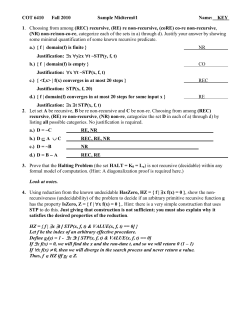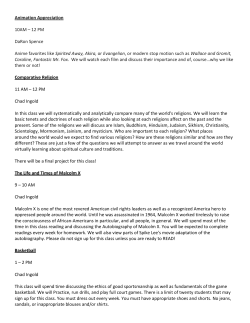
SAMPLE QUESTIONS FOR PhD QUALIFYING EXAMINATION CS 6352-Performance Computer Networks
SAMPLE QUESTIONS FOR PhD QUALIFYING EXAMINATION
CS 6352-Performance Computer Networks
1. Into a single queue with unlimited buffer size, customers always arrive in pairs but line up
one after another in the waiting line for service. One of an arriving pair joins the line ahead of the
other, by a random choice. The single server takes up one customer at a time from the head of
the queue and serves. Each customer leaves immediately upon completion of his/her service (that
is, without waiting for the completion of the partner’s service). Arrivals of pairs are Poisson
with a rate of 1 pair per hour. Service times of individual customers are independent and
identically distributed Exponential random variables with a mean of 0.25 hour for each customer
(and not for a pair). Determine the expected response time of an individual customer.
2. Consider a two-processor server where each processor in enabled with technology that allows
the processors to operate at a higher speed under heavy loads, and to operate at a reduced speed
under low loads to conserve power. Users submit jobs according to a Poisson process with rate
jobs per second. If there is one job in the system, only a single processor is busy, and the
processor operates at a speed of 500 MHz (500 million cycles per second). If there are two jobs
in the system, both processors are busy, and each operates at a speed of 1000 MHz. If there are
three or more jobs in the system, both processors are busy, and each processor operates at a
speed of 1500 MHz. The length of a job is modeled as exponentially distributed and requires an
average of 500 million CPU cycles. Buffer size is unlimited.
(a) Draw the state diagram for the system, clearly labeling transition rates.
(b) Find the steady-state probabilities for the number of jobs in the system.
(c) Find the condition for in order for the system to be stable.
CS 6353-Compiler Construction
Syntax Analysis
Explain why the following grammar is LALR(1) but not SLR(1).
S
a|bAc|dc|bda
A d
Intermediate Code Generation
Give a syntax-directed translation scheme for the while-loop, i.e.
Rule1
while (E1) do S1; { define your action here }
The while-loop has the common meaning and you can use either two pass approach or backpatching. Synthesized attributes can be defined as necessary. In addition, there are two
predefined functions as follows:
newlabel(): return an unused new label L.
gen(X): generate three address code as indicated by X.
CS 6354-Software Engineering
1
System Description
Consider a system for maintaining patient records in a doctor’s office. The system should allow the user
to create records for new patients, update the information, and delete patient records. The system should
also generate billing information for insurance companies, record payments from the companies and
patients, generate bills for patients, and send reminders to patients regarding follow-up treatments.
For each patient, the system stores the name, social security number, date of birth, address, and
telephone number of the patient as well as the patient’s insurance company, employer, and name of
parent or guardian (if under 18 years), name of spouse (if married). The system also maintains the
medical history of each patient, including the date of each visit, the diagnosis, prescribed treatment,
duration of treatment, and the result.
The system must enable the user to perform the following functions:
1. For adding a new patient to the system, the user fills out a form containing the patient information and
submits it to the system. Various validation checks are performed by the system (duplicate name,
reasonable age, correct insurance company, etc.) and the record is accepted only if it passes these
checks. The user can also delete patient records.
2. For updating the record of a patient, the user fills out or updates the information (including date of
visit, diagnosis, total charge, patient and insurance payments, change of address, etc.). The system
accepts the updates if the validation checks are passed.
3. If the user wishes to generate bills for insurance companies, the system goes through all the patient
records and generates bills for new payments or payments that are past the due date. Letters and
addresses are prepared and printed.
4. Similarly, the user can generate bills for patients as well as send reminders for patients who need
follow-up treatment.
1. Requirements elicitation and analysis.
(i)
Draw a Use Case diagram showing the functions of the system. Show the system boundary, use
case(s), and actors.
2. Requirements analysis.
(i) Consider the following entity classes:
PatientRecordSystem (keeps track of the information about all the patients in the system);
CompanyInfo (name, address of the company and the name and telephone number of a point of
contact); Date (month, day, year); Status (information about the status of the patient, including
starting treatment, continuing treatment, recovered, etc.); History (keeps information for each visit by
a patient); PatientInfo (name, address, telephone number, parent/guardian info, date of birth, social
security number, marital status and spouse’s info, history, employer, insurance company); PersonInfo
(name, address, telephone number), VisitInfo (date, problem description, diagnosis, prescribed
treatment, duration - start & end dates, status, payment info); PaymentInfo (responsible party, amount
billed, amount paid);
Draw the Class diagram. Use all the classes listed above and do not use any classes not listed
above. Show all the associations, inheritances, aggregations, multiplicities, and roles.
2
3.
Consider an issue that arises in the implementation of the database for
the patient information system, namely, how to implement the database
subsystem. Give details of the following rationale management scenario
that might arise (give concise answers in English, not UML, with just a
few sentences in the space provided here).
(a)
(b)
(c)
(d)
(e)
(f)
State the problem.
Identify some proposals
Give some evaluation criterion (criteria).
Give some arguments.
Describe the resolution.
List possible action items
CS6360 - Database Systems
Problem 1
Consider the following relations:
Student (snum: integer, sname:string, major:string, level:string, age:integer)
Class (name:string, meets_at:time, room:string, fid:integer)
Enrolled (snum:integer, cname: string)
Faculty (fid:integer, fname:string, deptid:integer)
The meaning of these relations is straightforward; for example, Enrolled has one record per
student-class pair such that the student is enrolled in the class.
Write the following queries in SQL.
a. Find the age of the oldest student who is either a History major or enrolled in a course taught
by I. Teach.
b. Find the names of all classes that either meet in room R128 or have five or more students
enrolled.
c. Find the names of all students who are enrolled in two classes that meet at the same time.
d. Find the names of faculty members who teach in every room in which some class is taught.
e. Find the names of students who are enrolled in the maximum number of classes.
f. For each age value that appears in Students, find the level value that appears most often. For
example, if there are more FR level students aged 18 than SR, JR, or SO students aged 18, you
should print the pair (18, FR).
CS 6361-Requirements Engineering
1.
Functional– Structural/Behavioral & Non-Functional
3
a. RML (Requirements Modelling Language) pioneered in World Modeling, and defined a
formal semantics for the “Generalization” relationship. Using an example, concisely and
precisely explain what it means to define the generalization relationship as a partial order
relation.
b.
Consider the following definitions:
- IN (i, C, t): predicate asserting that token i is an instance of class C at time t;
- IS-A (C1, C2): time-independent predicate asserting that class C1 is a subclass of class C2;
- PROPDEF (C, a): time-independent function which gives the class to which the value of attribute a for instances
of C must belong.
Using an example, precisely describe what the following axiom means:
[PROPDEF (C, a) = E AND IS-A (D, C)] -> exists F [PROPDEF (D, a) = F AND IS-A (F, E)]
c. Give a simple example of a state transition using (Augmented) Petri Net formalism, and then
describe what it would mean to apply the three epistemological primitives (i.e., structural
dimensions) of object-orientation to the state(s) in your example.
d. (5) Using a (softgoal) dependency graph, represent the following process as precisely as
possible:
The developer states the non-functional requirement “Accounts should be secure", and refines it
into three sub-goals, for Integrity (guarding against unauthorized update or tampering),
Confidentiality (guarding against unauthorized disclosure), and Availability (guarding against
interruption of service) of the account. The developer further refines the Integrity goal into two
sub-goals, for Accuracy and Completeness of the account.
Now focusing on the Confidentiality Requirement in moving towards a secure target design, the
developer considers a list confidentiality assurance techniques and decides to use an
Authorization Technique. Repeating this process, the Authorization Technique is further refined
to goals for Identification, Authentication, and Access Rule Validation. At this moment, the
developer notices that Access Rule Validation has a positive impact on the accuracy of accounts,
as ill-intentioned users can be denied access and prevented from committing forgery. The
developer now further refines Authentication into a goal for “Require additional ID”, but feels
that this goal would have a negative impact on User-friendly access. Although User-Friendly
access hasn'
t yet been posted, it turns out that it is fairly important and should have been posted
in the very beginning. So, the developer now posts it as a goal, although an Authorization may be
seen negatively towards User-Friendly access if the Authorization involved something personal.
CS 6362-Software Architecture and Design
1. Consider the following declarations:
module M1
provides: w, n
4
requires: m
consist-of: module M12, function F11
module M12
end M12
provides: n;
requires: m;
has-access-to: module M2
int n, Boolean m
function F11
provides: w;
requires: n;
boolean w, int n
end F11
module M2
provides: m,q;
int m, char q
end M2
1.1
List the set of varables that M12 can access
1.2
The specification above has one inconsistency. What is the inconsistency?
2. Suppose you are to build a system to help buyers and sellers, in a real estate market, who are
interested only in the price and location of the real estate.
2.1 Depict a diagram of a software architecture in an implicit invocation style with control for
the system.
2.2 Depict graphically how the architecture in 4.1 can be implemented using the Java Event
Model.
CS 6363-Algorithms
1. Describe a polynomial time reduction from CLIQUE to VERTEX COVER. Prove that the
reduction is correct, i.e. prove that x CLIQUE if and only if f(x) VERTEX COVER, where f
is the function you define for the reduction.
2. Give a simple example of a directed graph with negative weight edges for which Dijkstra’s
algorithm produces incorrect answers. Explain.
3. Does the standard Ford-Fulkerson network algorithm for computing maximum flow from a
given source to a given sink, where the edges have capacity constraints, allow an arbitrary
selection for an augmenting path from the source to the sink in each successive residual network
and still manage to guarantee eventual termination with maximum flow? Explain why or why
not.
CS 6364-Artificial Intelligence
5
1. The knowledge base KB has one Boolean formula:
(x1 x2) (x2 x3)
Find an equivalent knowledge base in Conjunctive Normal Form (CNF).
2. Consider a student that passes the PhD qualifiers test on AI, and the PhD qualifiers test on
ALGORITHMS. Use Naïve Bayesian reasoning to decide if the student would produce a good
dissertation based on the following information:
1.
2.
3.
10% of all students can produce a good dissertation.
Among students that produce good dissertations 90% can pass the AI qualifiers,
and 80% can pass the ALGORITHMS qualifiers.
50% of the students that cannot produce a good dissertation are able to pass the
AI qualifiers test, and 30% are able to pass the ALGORITHMS qualifiers test.
Explain your conclusion.
CS 6367-Software Testing
1. Given a complicated software system to be tested, assume you have all the source code as
well as the final executable system. Assume also you have some documentation even though it
might be incomplete and/or out-of-date.
Assume that testing techniques such as equivalence partitioning, boundary-value analysis,
control flow-based testing (e.g., branch testing), dataflow-based testing (e.g. “all-uses”), faultbased testing are available. Make a suggestion on how to conduct unit testing, integration testing,
and system testing so that the selected testing techniques complement each other to provide a
cost-effective approach for detecting as many faults as possible.
Justify your answer and explain all the assumptions you make, it any.
2. (a) Given the pseudo-code below:
integer x,y;
read x;
read y;
x = abs(x) + 2;
z = 3;
if (even(x/y)){
for( int i = 0 ; i < (x+y) ; i++){
if ((i mod x) == 0)
z
= z * x ;
else
z = z * y;
}
print z
}
print x,y
1) draw a control flow graph showing all the def, c-use, p-use
actions.
2) construct the set of items to be covered for “all-uses” (i.e.,
6
the (def,c-use), (def, p-use) pairs).
3) Ensuring that each test increases the coverage, create test cases to
satisfy the “all-uses” strategy (explicitly state each
def-p-use, def-c-use pair covered by each test case).
(b) An exception is a signal that indicates that some sort of
exceptional condition (e.g., a run-time error) has occurred.
When an exception occurs, an “exception-handler” is invoked to
handle the exception. Explain if, how the possibility of
exceptions would affect the way you carry-out “all-uses”.
.
CS 6371-Software and Design Programing Language
1. It is well known that tail recursive programs are efficient because they can be converted
automatically into a program that contains only iteration. Consider a class of programs called
“almost tail recursive” which have tail recursion as the second last operation. The last operation
is usually a very simple operation involving an addition or multiplication. For example, factorial
is an almost tail recursive program.
fac(0) => 1
fac(n) => n*fac(n-1)
How can you convert an “almost tail recursive program” into a tail recursive program? You can
demonstrate your technique by showing how it transforms the factorial program into a tail
recursive factorial.
CS 6375-Machine Learning
Naïve Bayes Learning
Table below indicates training example for the target concept Play Tennis.
Day
D1
D2
D3
D4
D5
D6
D7
D8
D9
D10
D11
D12
D13
D14
Outlook
Sunny
Sunny
Overcast
Rain
Rain
Rain
Overcast
Sunny
Sunny
Rain
Sunny
Overcast
Overcast
Rain
Temperature
Hot
Hot
Hot
Mild
Cool
Cool
Cool
Mild
Cool
Mild
Mild
Mild
Hot
Mild
Humidity
High
High
High
High
Normal
Normal
Normal
High
Normal
Normal
Normal
High
Normal
High
Wind
Weak
Strong
Weak
Weak
Weak
Strong
Strong
Weak
Weak
Weak
Strong
Strong
Weak
Strong
PlayTennis
No
No
Yes
Yes
Yes
No
Yes
No
Yes
Yes
Yes
Yes
Yes
No
Use Naïve Bayes Learning Algorithm to decide how the new instance should be classified.
Show all the computation steps.
Outlook
< Sunny
Temp
Cool
Humidity
Normal
CS 6378-Advanced Operating Systems
Wind
Strong >
7
Question 1:
(a) The Schiper-Eggli-Sandoz protocol for causally ordered message delivery states that the
communication channels can be non-FIFO. However, the description does not state
anything about the reliability of channels. What will be the impact of message losses on
the operation of the Schiper-Eggli-Sandoz protocol? Provide explanations to support your
answer.
(b) Assume a system of N nodes. If all communication is broadcast (all nodes are
destinations of every message) is it still necessary for every message to carry O(N2)
dependency information? Would it be possible to ensure causally ordered delivery while
having each message carry less than O(N2) dependency information? If yes, how much
dependency information should each message carry and why? Explain your answer.
Question 2:
(a) The three-phase commit protocol is said to be non-blocking and resilient to single site
failure. This means that inspite of the failure of a single site, all the operational sites agree
on the outcome of the transaction by examining their local states. Is the three-phase
commit protocol resilient to the failure of more than one site? If so, prove your answer. If
not, provide a counter-example to support your answer.
(b) The state transition and the resultant sending of message(s) in the three-phase commit
protocol is atomic (either the message is sent to all the intended recipients or to none).
Would the correctness of the protocol be affected by relaxing the atomicity requirement?
Explain.
CS 6385-Algorithmic Aspects of Telecom Networks
1. A graph G = (V, E) is 2-connected if it is connected and the removal of its any node does
notdisconnect the graph (i.e. the remaining graph is connected). Briefly describe a O(|E|+|V|)time algorithm for determining whether or not any input graph G is 2-connected.
2. We are given 3 queuing systems, each having a 56Kbps line of 50% utilization. Assume there
is no limit on the buffer size and the messages are transmitted in the FIFO order. Messages arrive
independently, and the average message length is 2000 bits. (a) The first has exponentially
distributed message lengths. (b) The second has constant (2000-bit) message length. (c) In the
third, half the messages are 800 bits long and half are 3200 bits long. Calculate the waiting time
Tw for each of these 3 cases.
3. We would like to design a 2-connected network topology on a given set of nodes. Assume
that a cost matrix is given that contains the cost of connecting any two nodes. Consider the
following solution.
Step 1: Build a minimum cost spanning tree T1 (with any known algorithm)
Step 2: Identify the leaf nodes of T1. Let L be this set of leaf nodes.
Step 3: Build a minimum cost spanning tree T2 on the set L (with any known algorithm),
ignoring the rest of the nodes. Let G = T1 T2 be the created network topology, that is, the
union of the two trees.
8
(a) Show that the constructed graph G is 2-node-connected, that is, the removal of any single
node cannot disconnect it.
(b) Prove that this algorithm is not optimal, by providing a small example in which it does not
find the least expensive 2-node-connected network topology.
(c) Is it true that the cost of the solution that the above algorithm provides is at most twice the
cost of a minimum cost spanning tree? Justify your answer!
4. Assume we want to build a network with a simple ring topology. We can use links of 150
Mbit/s speed. The traffic demand between each pair X,Y of nodes is 1 Mbint/s, both from X to Y
and from Y to X (the X
Y traffic is carried independently of the Y
X traffic). Under these
conditions, how large ring can be built?
CS 6388-Software Project Planning & Management
1. Develop a W-level entity process for the design phase that includes the activities between the
time the requirements specification has been completed, and the time the algorithms and data
structures have been defined.
2. Suppose you are asked to perform the V&V project function during the Integration and Test of
a 64 KDSI semi-detached software package for producing environmental impact reports. Should
you agree to do the job alone, or should you ask for help? Explain.
CS 6390-Advanced Computer Networks
1.
Network Calculus
1. Let A be the cumulative arrival function into a system, B be the cumulative departure
function of the system. Give the definition of a service curve, i.e., if is the service curve,
express (t) as a function of A(t) and B(t).
2. Assume you have two systems S1 and S2 concatenated to each other, where 1 is the
service curve of S1 and 2 is the service curve of S2. What is the service curve of the entire
system S1; S2? (i.e., the service curve of S1 concentrated with S2).
2.
FCFS
What is the importance of the delay theorem for FCFS by Chlamtac, Farago and
Fumagalli (the parper entitled “A Deterministic Approach to the End-to-End Analysis of Packet
Flows in Connection-Oriented Networks”) as opposed to the original results of FCFS
multiplexors by R. L. Cruz (paper title “A Calculus for Network Delay Part I and II”)? i.e., how
does the former improve upon the results of the latter?
3. What is quality of service (QoS)?
Give an example of QoS defintion in ATM network;
9
4.
Describe and compare integrated service architecture (ISA)
and differentiated service (Diffserv) model.
5a. Assume that a router in the path between two hosts
communicating using TCP can sniff all the IP packets and send
them to a distant host C realiably. If host A is downloading a
file f from B, how can C get the entire contents of the file?
5b. If the sequence number field in TCP is to be increased to
64 bits and the data rate of the communication path between the
two end hosts is 100 Mbps, how long does it take for the
sequence number to wrap around?
6.
Route optimization is mobile IP is used when we want to
avoid the inefficient routing of packets from the source to the
home agent and then tunneling the packets from the home agent to
the destination host at the foreign network. Explain how this is
done and what are the disadvantages of this scheme?
10
© Copyright 2025





















